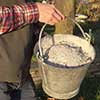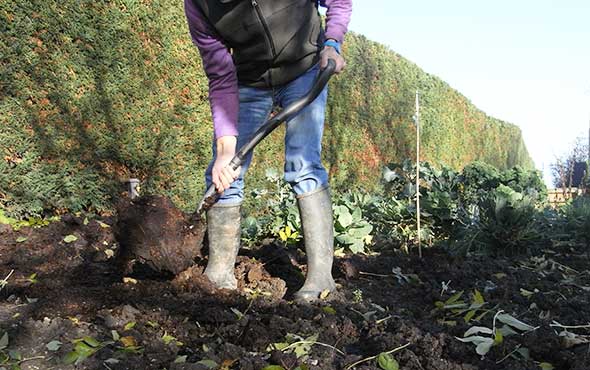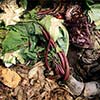Having organic soil that is rich in micro-organisms is the essential building block of organic gardening and the key to growing strong and healthy plants. It is often said “Feed your soil and your soil will feed your plants” and it is so true!
They say that a teaspoon of good organic soil can contain a billion micro-organisms. This complex subterranean life breaks down organic matter which provides the nutrients and trace elements needed for plants to thrive.
Plants don’t care where their nutrients come from but if we were to use artificial fertilisers, instead of organic matter, soil becomes lifeless. We would be providing the nutrients artificially but the majority of micro-organisms that exist to break down organic matter can no longer exist and the soil becomes no more than a ‘medium’ in which to anchor roots.
By destroying one part of the food chain, however small it may be, we change the balance of the whole ecosystem. It is well known that modern [non-organic] farming systems have caused a decline in wildlife, especially in our wild bird population.
If you’ve ever glazed over when reading the composition of a fertilizer whether organic or chemical, then you’re not alone. I never really understood what the NPK ratio was about until I researched it, but all you really need to know is you need enough of each of these nutrients in your soil for plants to grow well and as an organic gardener how you can get these into your soil by natural means.
The ‘NPK’ ratio is providing a ratio value for Nitrogen (N), Phosphorus (P) and Potash (K), all of which are important for growth. The letters are from the Periodic Table of the Elements which are used in chemistry.
By law, the amount of nitrogen, phosphorus and potassium contained in a pack of fertiliser must be stated on the packaging. If the NPK ratio on a packet is 5:6:4, it means that for every 100 grams of fertiliser, there is 5 grams of nitrogen (N), six grams of phosphorus (P) and four grams of potassium (K).
That’s not so hard to understand is it? So lets look at what each of these elements does for us and what we need to look out for if there is a shortage of one of these.
Nitrogen (N)
Nitrogen encourages the bushy, green growth of plants. An absence of nitrogen will cause small plants, sometimes yellowing leaves and spindly, weak stems. Leafy vegetables such as
lettuce and brassicas require a lot of nitrogen.
Nitrogen (N) is a non-mineral nutrient, it is a gas found in the air that we breathe and cannot be used in this form by plants so has to be fixed into the soil first.
Some soil bacteria take up N and as these bacteria die, it then becomes available to plants in the soil. Earthworms and other micro-organisms play a big roll in providing these N fixing bacteria, so by adding organic material to the soil, micro-organisms thrive and break down the material and as they die, they are putting N into your soil.
Fixing Nitrogen in the soil with plants
Another way of fixing nitrogen organically is via plants. Plants such as peas, beans and clovers have species of symbiotic bacteria called Rhizobia living in nodules in their root systems which capture N and helps the plant to grow. When these plants die, if we dig the roots in, the ‘fixed’ N is released into the soil. This is the process we are using with some green manures where we grow them and then dig them in to the soil.
Phosphorus (P)
Phosphorus in the soil encourages root growth. Plants are stronger with a larger root system as they are able to take up more nutrients, are more drought resistant and will be less susceptible to damage from the wind. If your plants aren’t thriving and have a poor root system when you dig them up, it is usually a shortage of phosphorus that causes this.
Potassium (K)
Potassium in soil encourages flower and fruit production. Low levels of potassium result in lower numbers of flowers and ultimately lower crop yields.
Wood ashes are high in potassium (up to 10%) but it does depend on the wood that was burnt. Conifers have a far lower value than broad leaf trees.

You can use them on the compost heap, or dig them in directly into the soil to change the pH but they are also a natural source of potassium and contain many trace elements such as iron, manganese, zinc, and copper.
Kelp and other seaweed is rich in potassium. Many seaweed based fertilisers are available, but if you visit the beach, why not collect a few bags of kelp? Dry it out in the sun and break it up into manageable pieces before digging it in. Alternatively, it can be steeped in a large bucket of water for 2-3 weeks and the resulting (rather smelly) mixture diluted down until it looks like tea and water it onto the garden.
Sulfate of potash (also called sulphate of potash, or arcanite) is another option. This is often mixed with blood and bone when making all round organic fertilisers. It contains virtually no chloride and salt (which some other potassium fertilisers contain and can be harmful to certain plants). Sulfate of potash can be purchased in garden centres or online and are usually 40-50% potassium.
Garden compost that has a high level of potassium can be made by composting a greater number of fruit and vegetables into the mix although this type of potassium is water soluble and can easily leach out of the soil, or compost heap if it isn’t covered over during the winter.
In nature, fallen leaves or dead plants and often dead insects or animals and their manure will decompose on the surface of the soil. With the help of micro-organisms to break them down, the nutrients that were locked away during their growth are returned to the soil.
Organic soil in our garden is dependent on having organic matter to break down and turn into nutrients that are then available for plants to take up in the next growing season. Some of these nutrients are lost through leaching (when there is rain for example) and nitrogen also evaporates, so it’s always an ongoing process replacing nutrients.
It isn’t possible to keep on growing plants without replacing the nutrients they use. As the nutrients decrease, so your plants become smaller, weaker and are more easily damaged by pests and diseases.
To replace lost nutrients to your vegetable garden, the most important thing to do is to add organic matter. This can be anything from your own garden compost, a green manure that is grown and then dug in to the soil, spent mushroom compost that can be bought by the tonne, or a well-rotted animal manure to your soil.

Lets look at each of them in turn.
Garden Compost
Most of us know what garden compost is and you don’t usually find a vegetable gardener without a compost heap somewhere in their garden! There are however, different ways to make compost, so if you’d like to read more about creating good compost then this page should help you:

An essential ingredient to the organic garden, one of the best things you can do for your garden is to learn how to make compost that can be incorporated into your garden.
Meanwhile, there are several other ways to improve your soil using garden manures such as:
Mushroom Compost
Spent mushroom compost is as the name suggests is compost that has been used to grow mushrooms commercially. Mushroom compost is made using organic materials such as straw, hay, corn cobs and chicken or horse manure. It is usually available for sale from specialist companies (an internet search will bring up a number of suppliers). It can be delivered in tonne bags which are convenient to use.
Horse Manure
Well rotted horse manure is one of the most readily available and if you have a trailer and some time to collect it, you can usually find a local supply that is going free, most people with more than a couple of horses end up with far too much of it. Do check what medication has been given to the horses though as you don’t want to end up with antibiotic residues in your soil.
Chicken Manure
If you keep chickens then …
Farm Yard Manure
With the high price of artificial fertilisers, many farms are either using all of their manure themselves, or selling it to other local farmers. It can usually be bought though and a farmer is usually willing to deliver using a tractor and trailer if you have an allotment or suitable access to your garden. A large trailer load will certainly keep a big garden going for a couple of years. Again, check whether the farmer uses many antibiotics as there can be residues in the manure.
Green Manure
…
As well as replacing nutrients in the soil, organic matter improves the soil structure. This is important as it provides oxygen in the soil for root growth and the survival of micro-organisms and it also helps to provide good drainage on heavy soils and moisture retention on light sandy soils.
Good soil structure allows plants to thrive by having an extensive root system allowing them to reach more nutrients and water.
Finally, remember that being organic in the vegetable garden but using weed killer on your paths or fertiliser on your lawn will not help. Every part of the garden inter-acts with another part, it is a delicate ecosystem. Killing microscopic organisms with chemicals in one part of the garden will upset the balance in another – so it is important to maintain organic principles as much as possible throughout the garden!
